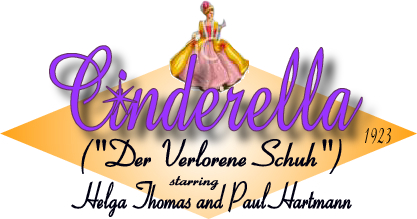

"Cinderella" is a magnificent and unique specimen from the artistic triumphs of the middle period of the German cinema; magnificent in its charming and beautiful realisation of this famous story against a background of delightful studio architecture and superb trick camera-work; and unique in the very fact that this technical proficiency was lavished upon charm, in contrast to the usual gloomy and morbid psychological introspections.
Ludwig Berger achieved fame with "Cinderella"
to which he added in 1926 with "The Waltz Dream" (UFA,
with Mady Christians, Willy Fritsch). Then proceeding to Hollywood,
he did "The Sins of the Fathers" (1929 with Emil Jannings)
and "The Vagabond King (1930 in colour, with Jeanette MacDonald
and Dennis King). In 1940, he shared with Tim Whelan and Michael
Powell the direction of "The Thief of Baghdad." It is
clear that "Cinderella" was inspired. There are signs
of detailed care having been lavished on its realisation to the
extent, for example, of a scheme of patterned photographic compositions
having been worked out for the long shots so that the action was
composed around a central feature set symmetrically in the frame.
This occurs frequently, e.g., the ballroom the palace staircase,
the king's bath, the various exteriors of 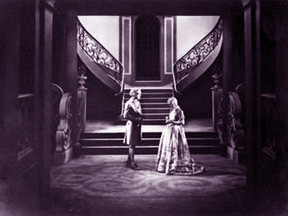 buildings,
etc., and proves a detailed pre-shooting linkage between director,
cameraman, and designer.
buildings,
etc., and proves a detailed pre-shooting linkage between director,
cameraman, and designer.
It is also of interest to note how the photographic compositions drift into the commonplace in the exterior scenes in the country. Cameraman Gunther Krampf was essentially of the studio, and rather at sea when he was unable to control the exact application of light. He also photographed "The Student of Prague" (1925 by Henrik Galeen with Werner Krauss, Conrad Veidt). The designer, Bamberger, was also on "The Waltz Dream." No scenarist is traceable. It is probable that Ludwig Berger did both adaptation and scenario himself (He did). The sustained atmosphere of charm points to this.
"Most Beautiful Fantasy"
Paul Rotha in The Film Till Now very aptly remarks, "'Cinderella' was a film of the most beautiful fantasy, delicately conceived and realised with a perfection of decorative pictorialism. The touch of Ludwig Berger seemed magical, so completely entrancing was the subtle fabrication of this exquisite work. Bamberger, for his design, centered his theme around the charm of southern Baroque art, making full use of the plastic moulding in which the German studio workers seem to excel. Technically, the magic in this film was brilliantly accomplished, for it was essentially cinematic."
The version available is just one fifth of the original, whole episodes having been ruthlessly cut out, including the famous battle of the witches. However, one fifth is better than no film, and it even adds to the praise due to this charming work that its logic and charm persist in the remnant. The excessive cutting has, however, inevitably caused jerkiness and hectic speed of action-narration, so that to consider the synopsis is valueless - and, accordingly, a direct examination of the available version follows . . .
The fairy godmother is introduced in a pleasantly untidy room with a window in the background through which sunlight streams. She is weaving the golden threads of her goddaughter's future. But Cinderella can see nothing till she looks through the magic spectacles when the arc of woven threads appears - a charming effect, done by simple superimposition. Then, looking into the magic mirror, a glimpse of the future is foreseen. In medium close-up, the stepmother adjusts her commanding face in a glass while her two daughters wrangle over their packing. These two young ladies (by no means ugly, as one had, of course, hoped) later achieved considerable fame in many films - Mady Christians particularly in "The Waltz Dream" which 'got' America, and Olga Tschechowa particularly in Rene Clair's "The Italian Straw Hat" (1929).
The arrival of their carriage is shown in two long shots in charming exteriors, specially built in the studio grounds. Footmen assist the new mistress who sweeps into the house ignoring Cinderella. Her father, sympathetic but already hen-pecked, is piled high with baggage by the cheerful "ugly" sisters. The three enter the hall and proceed up the stairs. The balusters of the staircase are a fine piece of period moulding in themselves.
The stepmother turns out the three old men to whom Cinderella was giving a meal in the kitchen and flounces back through the hall to the stairs in an exquisitely lit long shot. The carriage can still be seen through the open door. Soft daylight streams in, and a balanced composition is obtained by a fairly strong light on the stairs at the left side of the frame. The arches and Baroque style are charmingly in evidence. The sequence fades out on Cinderella unhappily sitting down by the kitchen hearth.
An introductory title for King Kindheart is followed by
a shot of his majesty in the colossal royal bath chamber shaking
water out of his eyes. Attendants solicitously dry him. Scribes
note his words as he decides to hold a ball to get the prince
married. The Prince is then introduced in a mid-shot playing a
'cello. The introductory title ("Prince 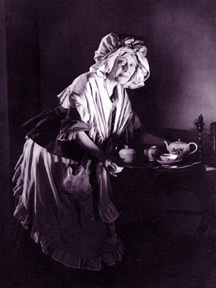 Charming
was lonely and sad") has been superimposed, an inartistic
and revolting trick which has nothing whatever to recommend it,
although it is, regrettably, still practised by people who either
think so little of their picture that they allow writing to be
scrawled across it, or so little of the title importance that
they permit its casual addition to any convenient dark area of
the picture.
Charming
was lonely and sad") has been superimposed, an inartistic
and revolting trick which has nothing whatever to recommend it,
although it is, regrettably, still practised by people who either
think so little of their picture that they allow writing to be
scrawled across it, or so little of the title importance that
they permit its casual addition to any convenient dark area of
the picture.
In this case, as the wording vanishes, ludicrously and as though by clockwork, the Prince stops playing and begins to look lonely. The superimposed title has the additional vice of stamping unreality all over the frame and effectively annuls the polished acting of Paul Hartmann. This player was also in the contemporary "Chronicle of the Grieshuus" made at the same studio, famous chiefly for its beautiful photography by Fritz Arno Wagner and available on 9.5mm.
The proclamation of the ball is read by a crier and attendants and heard enthusiastically by the stepmother from a balcony (another finely detailed set) and by Cinderella in the doorway below. But she cowers as she realises who is above - a neat directorial touch. She proceeds into the hall to the stairs, and in the distance, through the open door, we see the crier and attendants proceeding away, superb continuity of background action over a cut, and hardly ever seen nowadays due to the expense involved. Similarly, upstairs, when Cinderella asks if she may go to the ball, the courtyard can be seen through the window.
The Stepmother laughingly pours the beans into the cinders, and Cinderella starts to sort them out, sitting on the steps in the yard - and, charmingly, pigeons help her, so she finishes before the others start. But they laugh at her and drive off, the exteriors by night being most beautifully lit.
Shown in simple but effective superimposition, the ghosts of the three old men tell Cinderella to go and pray at her mother's grave. And doing so, she sees the shadowy figure of the Prince who kneels opposite to her then fades way. And in a lively mid-shot, the fairy godmother leans from a tower window and invokes a great wind, and leaves fall and blow around Cinderella. Miraculously her clothes change into a beautiful, shimmering dress of silver. The silver coach drives up, and, warned to leave before midnight, Cinderella is driven away.
The ballroom is a superb, accurate, and very beautiful set with magnificent chandeliers. The grouping of the players is unobtrusively excellent, and their movements graceful. In strange contrast to the Americans, the players wear their costumes as though they belong to them. Good comedy asides are provided by a shot of court gossip and the fact that the fairy godmother plays the piano. In another fine night exterior, the coach drives up. The Prince sees it coming and dashes down the stairs and reaches the door as it comes to rest. A lovely mid-shot follows of Cinderella alighting as the old coachman stands by. George John, remembered in "Siegfried," "Vaudeville," and "Metropolis," makes something even of this infinitesimal part.
The Prince gives Cinderella the flower for the most beautiful lady and leads her into the ballroom - and no comment whatever is made by anyone present because it has all been ruthlessly cut out in the process of condensing the available version, this being perhaps the most glaring example of how narrative logic is wrecked.
Charming Comedy
Suppertime is shown with charming comedy by a long shot of food being borne swiftly up the picturesque palace stairs by a vast staff. Cinderella and the Prince are left alone in the ballroom till she suddenly notices that it is five to twelve (C.S. of the clock, and, frantically redundant, a superimposed explanatory title!) She hurries out but is delayed by the Prince - then runs on again, and the fairy godmother baulks the Prince - with a touch of broad comedy. Then . . .
L.S. (camera in hall facing stairs: low position for dramatic emphasis, and stairs appear symmetrically), Cinderella anxiously runs up, then stops . . .
L.S. (camera in hall looking towards door). The silver coach
stands outside; but suddenly it vanishes in a cloud of smoke which
drifts away to reveal a huge clock indicating 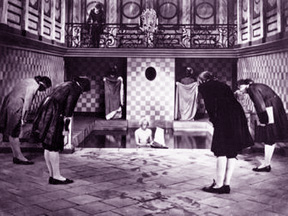 midnight.
midnight.
M.S. Cinderella stands petrified, and her silver dress fades back to her own humble clothes. She looks round apprehensively . . .
L.S. The Prince comes dashing down the stairs . . .
L.S. Cinderella melts into a shadowed corner, and the Prince passes by to the door, not seeing her. (Strong light through the doorway emphasizes the shadow, besides making a dramatic pictorial composition).
Then Cinderella runs off, losing her slipper, and the Prince gives chase but is thwarted by the fairy godmother who causes a bridge to separate, then flings an invisible mantle over Cinderella (a reverse-motion trick double-exposure). The sequence fades out on a close-up of the Prince fondling the flower (spoiled by a jerk of his head in the middle where a foot or so has been scooped out in the condensing ritual.)
Simple Trick Shot
The Prince love-sickly fondles the slipper, and it is decided, in a delightful mid-shot of the anxious court personnel, that the slipper should be removed to cure him. The luckless recipient of this job stealthily approaches, watched by the fairy godmother in her magic glass. When he touches the slipper there is a flash and, struck down, he quickly fades out leaving a patch on the carpet from which the Prince, startled, recovers the slipper. And the wretched man, dwarfed, is safely imprisoned in a glass jar.
The scale effect is used here, and backed up in a close-up showing the man beating against the glass. It should be noted that the trick construction in the mid-shot is simple. One exposure would straightforwardly show the godmother and the empty jar. The second exposure, made only on that portion of the frame representing part of the interior of the jar, would be a long distant shot of the man such that his full-length figure fitted easily into that portion.
In a sequence confused by excessive condensation, Cinderella is sent to the palace with fruit, disguised as a gipsy, but becomes confused and runs away losing another slipper. She cries, and the tears miraculously restore her pale skin and blonde hair just as the Prince comes up, sees her feet, and tries to fit the slippers - but she runs off again. Meantime, with an explosion and a slow mix, the fairy godmother has built a small model palace for them. Cinderella runs in, but the doors shut in the Prince's face. He throws down the slipper (one got lost, apparently in continuity) and it immediately changes into a crown. Then, again, in characteristic symmetrical mid-shot, Cinderella appears, clad once more in the silver dress, and kneels to receive the crown - and from the upper windows gape down the courtiers until . . .
Skilful Direction
M.S. from the roof the fairy godmother drops some handkerchiefs . . .
L.S. . . . which magically fasten over their eyes.
M.S. The Prince and Cinderella break their embrace to look up at this queer commotion.
L.S. Then the fairy godmother makes the shutters close for double assurance, and . . .
M.S. . . . draws her gauze shawl around herself and fades away.
M.S. the Prince and Cinderella enter their palace . . . SLOW FADE OUT
THE END
SCENARIO AND DIRECTION
These phases are here closely linked and are not easy to separate. Charming touches, additional to those already mentioned, include the serio-comic dejection of the hen-pecked Baron, the Fairy Godmother marshalling the pigeons to help in sorting the beans from the cinders, the finding of he key in the well-bucket, the stepmother pushing her daughters ruthlessly in front of the Prince at the ball, and the worried attendant who quickly polishes the second slipper before taking it to the Prince.
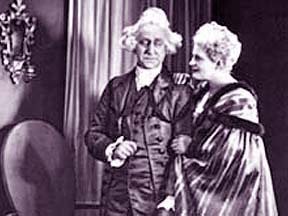 PHOTOGRAPHY
PHOTOGRAPHY
The very perfection of Gunthur Krampf's compositions in all the studio shots (tho' his close-ups are less excellent), and the facility and precision with which the trick effects are accomplished, throw into relief the poor quality of the exteriors.
With the exception of films containing "epic" exteriors, such as "The White Hell of Pitz Palu" and "The Edge of the World," it is really remarkable how little advantage is taken of the possibilities of good quality exteriors. Even the competent "The Lost World" is quite uninspired in this direction. If one ponders on memorable exteriors, excluding the above-mentioned and similar epics and Fanck or Riefenstahl Alpine wizardry ("Blue Light," "White Flame," "Sacred Mountain"), what comes to mind . . .? One recalls Baia, Baia of the vivid crimson in Disney's "Three Caballeros" . . . the meadow in "Bambi" . . . And these are paintings, not photographs! One recalls the countryside and the mill opening "The End of St. Petersburg" . . . (the "Siegfried" forest and birch glade were made in the studio) . . . the sweep of the trail in John Ford's "Stagecoach," the views of castle and lake in "Königsmark," the camp by the river in "Henry V." These come clearly to mind while the images of the countryside in "A Canterbury Tale" and "Tawny Pipet" are blurred and half-forgotten. Reference to the powerful and striking compositions secured by the still photographers, as may be found in such collections as "Photograms of the Year," indicates that there is much room for improvement in this part of the Cinematographer's art.
ACTING
Helga Thomas and Paul Hartmann are quietly charming. They wear period dress admirably. Lucie Hoflich is rather heavy-handed as the stepmother and tends to overact in close-ups (stage technique obtrudes). Best performances are from the famed Frieda Richard who was also in "Faust," and the unnamed player who makes a twinkling study of King Kindheart (identified as Leonhard Haskel).
MONTAGE
The original rhythm is lost in the fragment, but many cuts are done with excellent precision, notably the appearance of the clock at midnight.
DESIGN
This is the very memorable framework wherein this jewel of a film is set. It shares with "Caligari" and "Faust" the unusual attribute that, in thinking about the film, one first recalls the remarkable beauty of the design.
It says a lot for the power of the cinema image that, in cutting down a not-overlong original to one fifth, narrative and characterisations and backgrounds manage to subsist. One cannot, for example, imagine a lucid one-act version of "Hamlet." Even in these two reels one gets to know the Prince and Cinderella and the king and all the rest down to the queer coachman. And one remembers the ballroom and the lovely grace of the Baroque buildings, and the silver coach, and the clock at midnight, and the blindfolded courtiers, and the symbolic happy-ever-after. This success is due in part to the skill given to each phase of production, but, in the main, to Ludwig Berger whose direction resulted in so unified and charming a film.